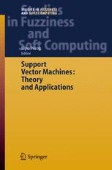Search
Search Results
-
Fuzzy Caley's Theorem and Fuzzy Lagrange's Theorem
We begin our discussion with properties of normal fuzzy subgroups. Fuzzy analogs of some group theoretic concepts such as cosets, characteristic...
-
Fuzzy Subgroups of Abelian Groups
Some of the best examples of algebraic structure theory come from commutative group theory. Commutative group theory is also a principal reason for...
-
Random Voronoi Ensembles for Gene Selection in DNA Microarray Data
Currently, cancer and other complex pathologies are analyzed mainly by morphological classification. In the past few decades there have been dramatic...
-
Cancer Classification with Microarray Data Using Support Vector Machines
Microarrays (Schena et al. 1995) are also called gene chips or DNA chips. On a microarray chip, there are thousands of spots. Each spot contains the...
-
Class Prediction with Microarray Datasets
Microarray technology is having a significant impact in the biological and medical sciences and class prediction will play an increasingly important...
-
A Dynamic Model of Gene Regulatory Networks Based on Inertia Principle
In molecular biology, functions are produced by a set of macromolecules that interact at different levels. Genes and their products, proteins,...
-
Conclusions
This chapter concludes this monograph. It starts with the summary of the progress, results, and status of the research project, followed by tasks of...
-
A First Improvement: Using Promoters
Harik [47] took Holland’s call [53] for evolution of tight genetic linkage and proposed the linkage learning genetic algorithm (LLGA), which used a...
-
Logical Regression Analysis: From Mathematical Formulas to Linguistic Rules
Data mining means the discovery of knowledge from (a large amount of)data, and so data mining should provide not only predictions but also knowledge...
-
Convergence Time for the Linkage Learning Genetic Algorithm
As indicated in the previous chapter, inspired by the coding mechanism existing in genetics, introducing the use of promoters in the linkage learning...
-
Introducing Subchromosome Representations
While the linkage learning genetic algorithm achieved successful genetic linkage learning on problems with badly scaled building blocks, it was less...
-
Privacy-Preserving Data Mining
The growth of data mining has raised concerns among privacy advocates. Some of this is based on a misunderstanding of what data mining does. The...
-
COGNITIVE PROCESSING IN ACOUSTICS
The idea of vagueness (contrary to bi-valent logic) appeared at the end of the 19th century, and was formally applied to the field of logic in 1923...
-
Free Fuzzy Subgroups and Fuzzy Subgroup Presentations
In this chapter, we define a notion of a free fuzzy subgroup and study its basic properties. We examine two approaches. The first approach is based...
-
Active-Set Methods for Support Vector Machines
This chapter describes an active-set algorithm for quadratic programming problems that arise from the computation of support vector machines (SVMs)....
-
The Self-Organising Kernel Memory (SOKM)
In the previous chapter, various topological representations in terms of the kernel memory concept have been discussed together with some...
-
Local Learning vs. Global Learning: An Introduction to Maxi-Min Margin Machine
We present a unifying theory of the Maxi-Min Margin Machine (M4) that subsumes the Support Vector Machine (SVM), the Minimax Probability Machine...
-
Introduction
“What is mind?” When you are asked such a question, you may be probably confused, because you do not exactly know how to answer, though you...
-
Learning in the AMS Context
In this chapter, we dig further into the notion of “learning” within the AMS context. In conventional connectionist models, the term “learning” is...
-
Membership Functions From Similarity Relations
Let G be a group and μ a fuzzy subgroup of G. Then μ can be thought to be the membership function of a fuzzy subgroup of G. In this chapter, we...
